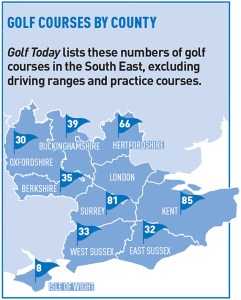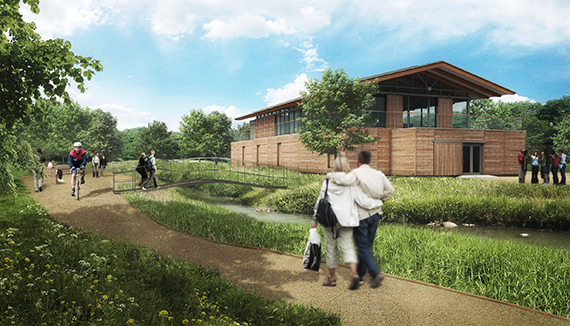
Could building on golf courses be a hole in one for the South East’s housing shortage? It is a sign of the scale of the housing problem that increasingly unusual options are being considered.
And it is hardly a far-fetched idea given golf’s long-term decline in popularity.
The number of people who play golf once a month or more on full-size courses in England fell by 25,000 to just over 1.1m between October 2014 and September 2015, according to Sport England’s Active People survey.
Back in 2008, the total exceeded 1.54m. Weekly playing rose by 10,000 in the latest survey, although at 740,100 it is 200,000 below the 2008 figure.
But despite the drop, few courses have closed. For example, Golf Today magazine lists 30 full-size courses in Oxfordshire, not including driving ranges and practice areas. This may seem a lot, but in fact the county has relatively few compared with others in the region.
It is perhaps unsurprising that those pondering Oxford’s housing problems – average homes cost 16 times the typical salary compared to 15.7 in London, according to Oxford University research – are suggesting unorthodox solutions.
Chris Findley, planning and property solicitor at Bircham Dyson Bell, recently told a Strutt & Parker seminar on Oxford’s housing crisis that the county had allocated more land to golf courses than to housing in the past 30 years.
“Golf courses are brownfield sites that happen to look green, and they’re fair game for development,” says Findley.
The Oxfordshire Growth Board, a cross-council body, wants to find locations for Oxford’s estimated 15,000 overspill homes. “Locations being assessed do include golf courses,” says David Jackson, head of planning at Savills. A final spatial strategy will be revealed later this year, and until then individual councils are not naming any courses under review.
One issue facing most local authorities and developers is the lack of experience of developing golf course land. In the South East, only Kent’s Herne Bay course has in recent years made the transition to housing (see box, right).
West Chiltington Golf Club in West Sussex was sold to Nyetimber Vineyard in February with no apparent proposal for housing. Mentmore Golf and Country Club near Leighton Buzzard, Bedfordshire, closed last summer, again with no development plans.
Outside the South East, Norfolk’s Royal Norwich Golf Course is being relocated to release land for housing, and a former municipal course at Tamworth, Staffordshire, is to become a site for 1,100 homes.
But the developer at Herne Bay says that if any courses are earmarked in future for redevelopment, they offer an interesting challenge to builders.
“Courses typically have mature and high-quality landscapes that create an instant setting for a development and help place-making,” says Mark Quinn of Quinn Estates, which is developing the Herne Bay course into 572 homes and shops. “There is limited ecology due to pesticides and a club house can be converted into a dwelling if need be.”
But there are downsides – and not only the fact that some courses built in the past 30 years are on flood plains. “A golf course usually has entrenched use from its local community and closure can upset many people with the loss of green space and sporting facilities,” says Quinn. “Community engagement is key. A community benefit can be created to make up for this loss, which could perhaps be a new leisure facility.”
The surprise is that so few developers and councils have spoken openly about golf course redevelopment to date – perhaps because of a perceived heavy overlap between players and property professionals.
But with more than 400 courses in the South East outside Greater London, and the game in the rough when it comes to attracting footfall, expect a debate to begin soon with the need for more land for housing to the fore.

Case Study
Herne Bay’s 116-year-old golf course closed in 2011 after a family feud among the owners – thus avoiding the scale of protests that some courses have seen when they have been closed following approaches by developers.
Interest in the site has been expressed by a supermarket group and a local grammar school, and there has been tentative exploration of plans for a
new 90-room hotel and pub.
Eventually, it was sold for £1.2m to a nearby fruit farmer advised by Quinn Estates, and Quinn and Redrow are now building out on the 100-acre site.
There will be 572 houses and a 15-acre “sports super hub” with facilities for tennis, football, cricket, hockey and other sports. There will also be 45,000
sq ft of commercial space.











